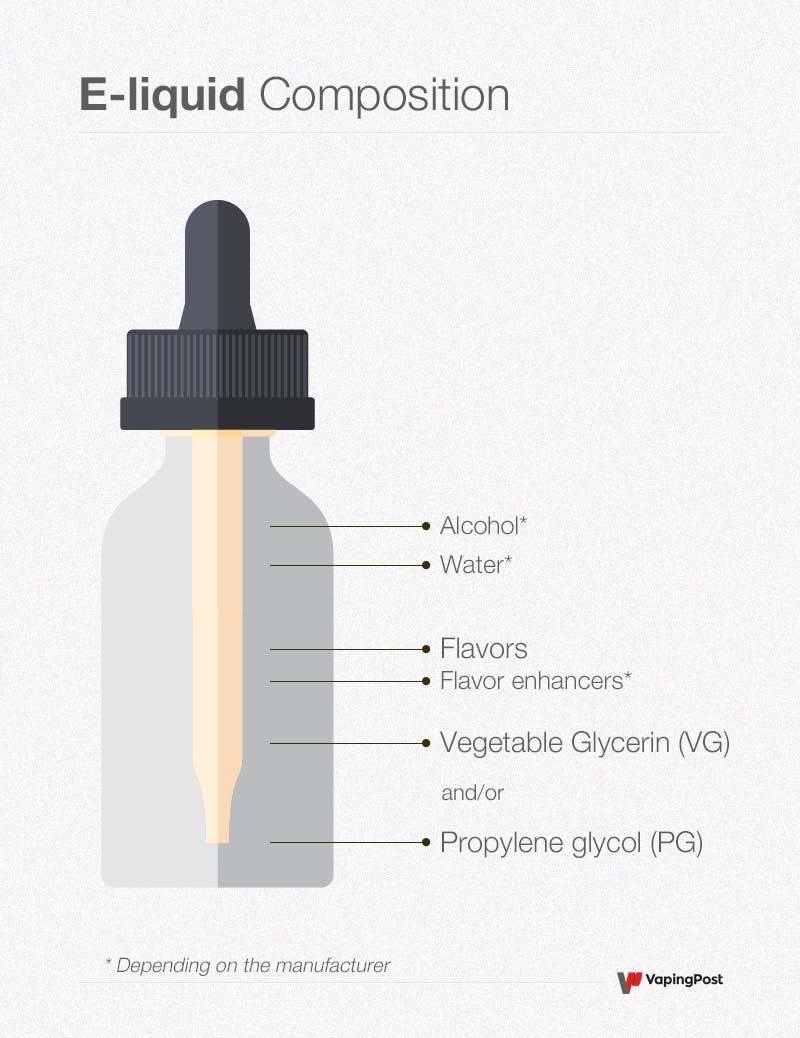Without an e-liquid, there is no vapour. Whilst the secrets to the flavours captured inside this viscous and sometimes amber-coloured solution may be kept under wraps, its key ingredients are easily accessible. Our guide to how e-cigarettes work gives you an overview of e-liquids with a closer look at what they are made of.
Composition of an e-liquid
Relatively simple ingredients
Are you looking for specific information about what is contained in liquids for e-cigarettes? You’ve come to the right place! The Vaping Post has put together a set of detailed guides covering the biggest questions on vaping, looking in particular at the main ingredients found in “e-juices”.  The basic ingredients usually found in an e-liquid are as follows (in descending order by quantity):
The basic ingredients usually found in an e-liquid are as follows (in descending order by quantity):
- Propylene glycol
- Vegetable glycerin
- Flavours and flavour enhancers
- Water
- Alcohol
What do concert hall smoke machines, croissants and toothpaste have in common?
Propylene glycol
This is the key ingredient in e-liquids and has been used for years in e-cigarette refills. But it is more commonly used in other consumer products than you would think. Propylene glycol (PG) has actually been widely used for a long time as a moistening agent in cosmetics, pharmaceutical products and food (E1520). We breathe it in, ingest it and spread it on our skin. Read this article to find out everything you need to know about propylene glycol.
Did you know?
- In e-liquids for e-cigarettes, propylene glycol tends to accentuate the flavours and increase your throat hit. It is more fluid than vegetable glycerin and has a slightly sweet taste.
- Based on current scientific knowledge, it presents no major risks to your health in terms of toxicity when ingested or taken by mouth. It is not considered to be toxic when used in night clubs or theatres.
- Whilst the toxicological profile of propylene glycol appears to lend itself to being inhaled (2), there is little documented scientific evidence of its long-term effects.
Vegetable glycerin
Also used in food (E422), cosmetics or pharmaceuticals, vegetable glycerin (VG) does not present any risk to the body when absorbed via digestion or through the skin. Also known as glycerol, this ingredient found in e-liquids is produced by converting vegetable oils.
Did you know?
- Vegetable glycerin increases vapour production
- However, it also tends to reduce the sensation of flavour in your mouth
- It generally constitutes around 50% of the ingredients in e-liquids, but is gradually increasing (certain e-liquids can even contain 100% vegetable glycerin, also known as Full VG).
- Inhaling vegetable glycerin does not appear to cause any major health issues (3, 4).
Flavors
The flavours used in e-liquids for e-cigarettes are usually food grade and may be produced anywhere in the world, particularly in France. For example, the Grasse region of France is renowned for excelling in this field. Nowadays, this means that companies which supply flavours to the food or cosmetics industry also serve the vaping industry. Concerns on the implications of using flavours in vapour have been brought up on several occasions, and are now being increasingly addressed by science. Heat may, in fact, create complex physical and chemical reactions associated with flavours. For example, the production of aldehydes such as benzaldehyde in certain cherry flavours was widely reported in the media in 2016.
This is also the case for diacetyl which produces a buttery flavour in e-liquids. Whilst there are emerging concerns within the scientific community about flavours contained in e-liquids, these have not yet been able to offset the vastly lower risks associated with using e-cigarettes rather than smoking tobacco.
The e-liquids sector is becoming increasingly corporate, and we know of certain companies such as Gaïatrend (producing the Alfaliquid brand) and Bordeaux-based Vincent which were very quick to establish which flavours are deemed to be more suitable for vaping than
Making the right choice
We advise choosing e-liquids from well-known brands with the most transparent production processes. Finally, opt for a manufacturer with robust internal expertise.
Nicotine
It is the ingredient that is the subject of all the questions. Wrongly associated with the harms of tobacco, nicotine is central to the mechanisms of addiction to smoked tobacco. However, at the doses administered by the smoker or vaper, nicotine does not present any major health risks, unlike the highly toxic compounds produced by the combustion of tobacco. Follow the scientific explanations we have prepared for you with the help of specialists on the subject.
How is an e-liquid made?
Strict manufacturing standards apply to e-liquids, involving a surprising amount of industrial equipment and expertise for the contents of such a simple little bottle. In early 2018, we produced an exclusive, unique report on the production of e-liquids. From taking delivery of the raw materials to the packaging process, from product design to the analyses, we take you on a tour of France’s biggest site for the field.
A little bit of history
A neutral e-liquid, i.e. without a flavour, has a very light taste. But the reason why e-cigarettes are so popular is mostly because of the pleasurable effect on the palette. That’s why e-cigarettes were marketed with flavoured e-liquids right from the start. Tobacco and menthol were the most commonly developed flavours, to imitate tobacco cigarettes. But other, much more complex flavours soon appeared on the market. One of the most well-known examples in the history of vaping was the famous RY4 created by Ruyan (the company founded by Hon Lik which marketed the first e-cigarettes in China in 2003). There are too many more to mention, but the Halo Tribeca (Nicopure) in the USA, the Alien Visions Boba’s Bounty (USA), and the T-Juice Red Astaire in the United Kingdom particularly stand out as key players in the history of e-liquids.
Should we avoid certain e-liquids?
As with all industries, some companies are less scrupulous than others. In Europe they have professional brands which have been operating for many years, and have worked with the French Interprofessional Vaping Federation FIVAPE to introduce the world’s first e-liquid production standards (the famous AFNOR standards).
The controversy surrounding diacetyl
Attributed to the illness of popcorn workers, diacetyl is a compound used in the food industry to bring a very pleasant buttery taste to food. However, its high concentration in the air we breathe can pose serious health risks in the long term. In the world of e-liquids, this ingredient can be used for the same taste purposes, but some manufacturers have sometimes abused its use and high doses have been found in several e-liquids. We tell the whole story in our article on diacetyl.
References
(2) Robertson OH, Loosli CG. Tests for the chronic toxicity of propylene glycol and triethylene glycol on monkeys and rats by vapor inhalation and oral administration. J Pharmacol Exp Ther 1947;91:52-76. (3) Anderson RC, Harris PN, Chen KK. Toxicological studies on synthetic glycerin. J Am Pharm Assoc 1950;39:583-5. (4) Reindeer RA, Wehner AP, Greenspan BJ et al. 2-week and 13-week inhalation studies of aerosolized glycerol in rats. Inhal Toxicol 1992;4:95-111.
The E-liquids FAQ
Below is the list of frequently asked questions about e-cigarette e-liquids. If you can’t find an answer to your question, feel free to leave your question in the comment box below.
- How do I choose my e-liquid?
The most important thing is that your e-liquid suits your immediate needs and tastes. If you are currently trying to give up smoking, we strongly recommend trying tobacco-flavoured e-liquids as these will best imitate the taste of your cigarettes. However, if cigarettes are now just a bad memory and you want to try something new, your best bet is to treat yourself to more exotic flavours!
- Where do I go to try e-liquids?
If you are interested in a particular e-liquid and would like to try it before buying it, the easiest way is to visit your nearest store and ask your favourite sales assistant. If you want to test an e-liquid at home, we recommend using a dripper.
- How do I make my e-liquid last longer?
If reducing the amount of e-liquid you use is your priority, we recommend vaping using a single coil device and at the lowest temperature possible.
- Where should I buy my e-liquid?
There are a range of options. You can of course visit your nearest store, or you can order from one of the many e-liquid websites. We recommend searching the internet for a particular e-liquid, as the price may vary depending on the seller.
- When should I add more e-liquid?
For atomisers or clearomisers with a transparent tank, we recommend filling your device with e-liquid when the level is very low. If using a dripper, try to get into the habit of knowing how many puffs you can take before needing to moisten the wick on the coil.
- Why is my e-liquid changing colour?
There are many reasons why the colour of an e-liquid may change. The nicotine content in your e-liquid may make the colour vary. For example, an e-liquid with a nicotine level of 18mg will generally be darker than the same product containing just 3mg of nicotine. The temperature, UV rays, sunshine and oxidisation may also make your e-liquid turn dull. However, it is important to note that these changes in colour do not alter the properties of your e-liquid in any way, and you can still use it for vaping without any problems.
- Why does my e-liquid make me cough?
Some people complain that they cough when they start using e-cigarettes, which wasn’t the case when they smoked cigarettes. This reaction is completely normal. Think about when you smoked your first cigarette – we’re pretty certain you will also have coughed then! There are lots of other reasons why you might cough. Some people are sensitive to the propylene glycol found in e-liquids – if this is you, try an e-liquid containing less PG. You may also cough if you are vaping at too high a power level. Simply try reducing the wattage to eliminate this issue. Finally, overly high levels of nicotine in your e-liquid may also be the reason for your cough. Try to find an e-liquid with a lower nicotine level.
- Where can I find cheap e-liquid?
Everyone would like to pay less for their e-liquid, or would even like to try making their own. You can find all the answers you need in our article, Where can I find cheap e-liquid?













